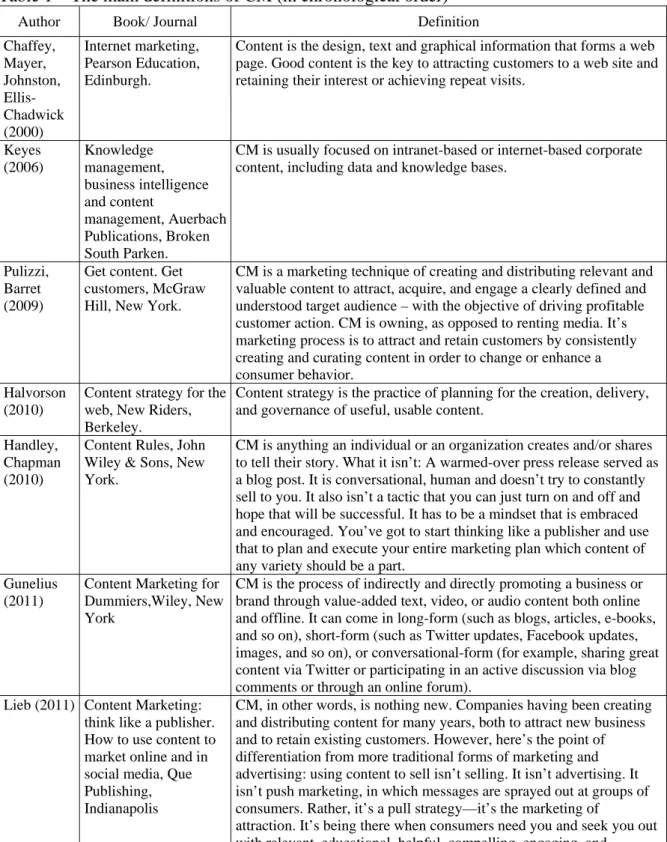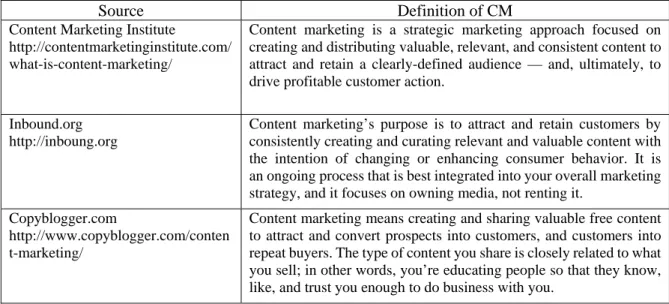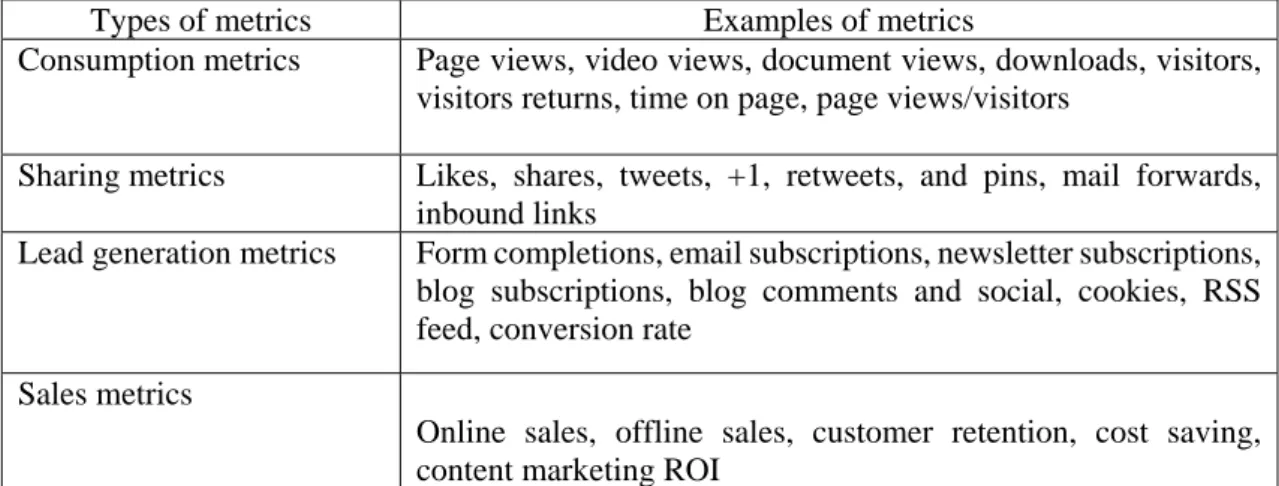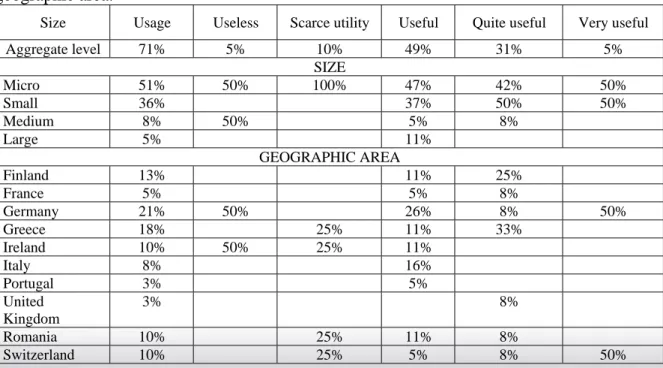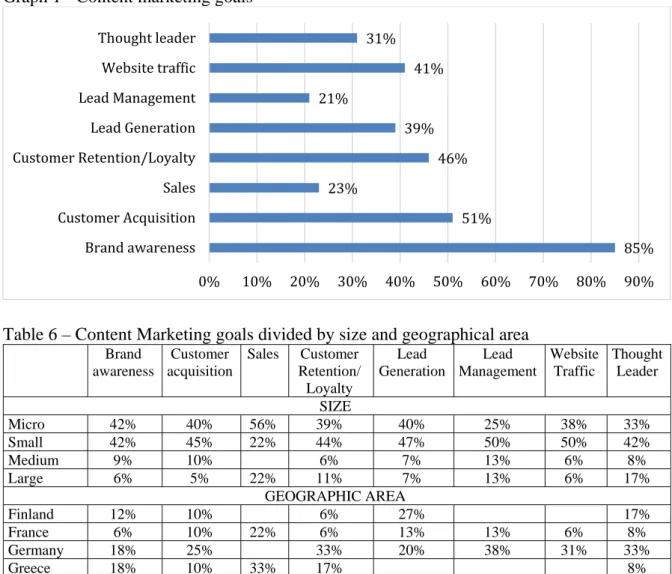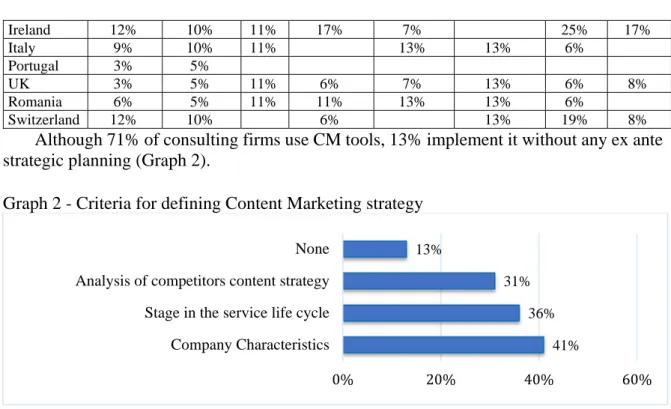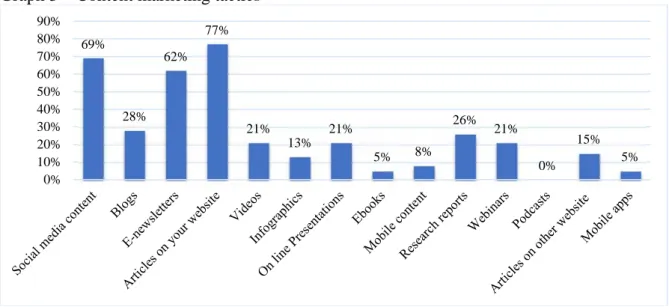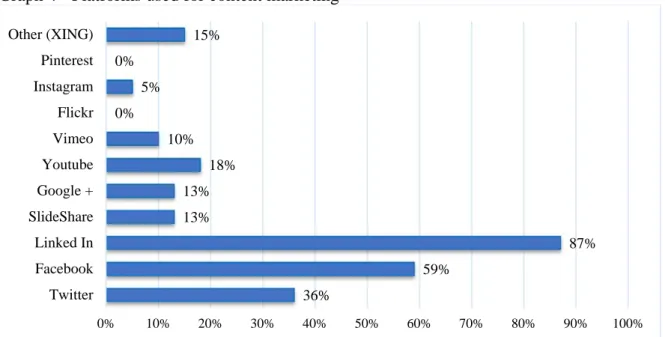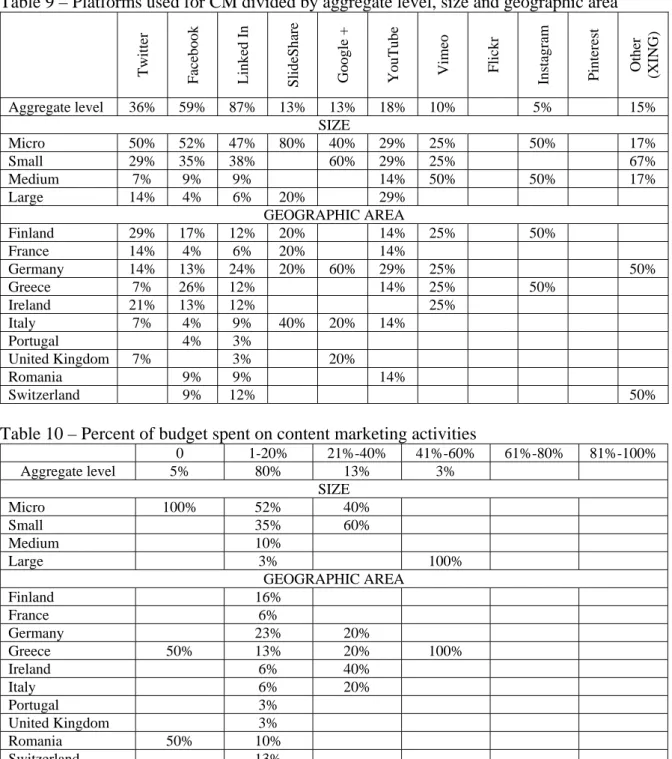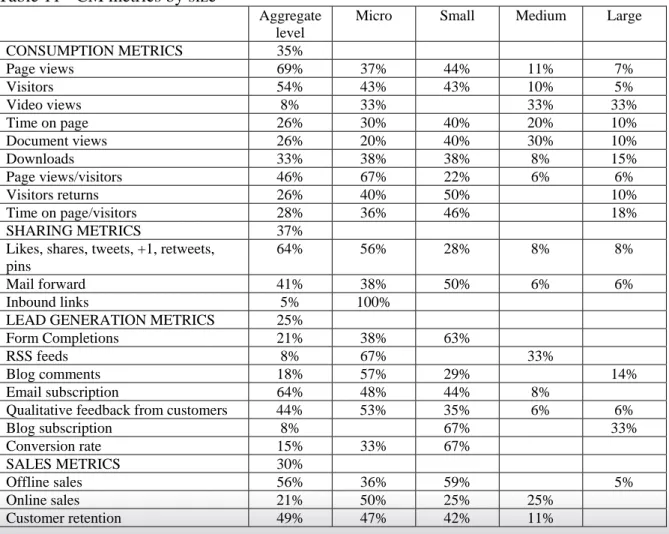CONTENT MARKETING TOOLS AND
METRICS IN CONSULTING FIRMS:
PRELIMINARY RESULTS
Linda Gabbianelli
Carlo Bo University of Urbino, ItalyEmanuela Conti
Carlo Bo University of Urbino, ItalyReceived: July 29, 2018 Accepted: November 30, 2018 Online Published: December 5, 2018
Abstract
The aim of this work is to identify the goals, tools, strategies, and metrics of Content Marketing (CM) used by European consulting firms to create value for the customer. The study adopts a quantitative methodology, in particular an online survey. A sample of 55 respondents was analyzed using descriptive statistics. CM is an activity used by 71% of the sample and is considered useful by 85% of respondents. The goals pursued with CM are mainly brand awareness and customer acquisition. The main platforms used for CM are LinkedIn, Facebook, and Twitter. The tools most often adopted to achieve CM goals are website articles, social media content, and newsletters. The most used metrics are publishing and sharing. The small sample reduces the possibility to generalize the results. The results give some managerial implications such as: invest more in CM; use CM for maintaining contacts and increasing sales and use platforms like Instagram and YouTube; CM strategy planning. The study suggests a new CM definition which includes specific targets, the growing importance of digital tools and planned and systemic approach. This work is original as it is the first application of CM to consulting firms and contributes to the definition of CM.
Keywords: Content marketing (CM); Value creation; CM instruments; Performance measurements; Consulting firms.
1. Introduction
The concept of content marketing (CM) is built around a new approach to marketing communication activities based on the creation of quality content that pursues various goals such as customer engagement and brand awareness. “Content” may refer to a wide range of elements such as stories, news, information, product ideas, messages, and videos (Handley and Chapman, 2010). In recent years, CM has become very popular, especially in the business community, while in the academic sphere it has so far received little attention on the conceptual and empirical level. Practitioners’ interest in this concept is evidenced by the
diffusion within companies of a specialized professional figure (e.g. Chief Content Officer) that deals with the creation and management of business content (text, video, audio, animation) sent via different channels (Vollero, Palace, 2015).
This paper examines the CM concept, seeks to identify goals, tools, and metrics to measure its impact on the performance of consulting firms. In particular, this work provides a twofold contribution: 1) it analyzes the literature on the concept of CM and the main metrics used to measure it; 2) it examines the degree to which CM strategies and metrics are used by consulting firms.
The study is structured as follows: the first section presents a literature review of the main contributions to CM and the main metrics used for its measurement; section 2 illustrates the methodology adopted for the empirical survey; section 3 illustrates the preliminary results of the study on the use of CM and on the measurement, metrics used by European consulting firms. Section 4 discusses the results of the research. The last section contains the main results, the theoretical and managerial implications, the limitations of the research, and suggestions for future studies.
2. Theoretical background
The fact that there is a scarcity of literature on "content marketing" is due to the fact that "content" has rarely been the first object of marketing studies, especially in digital contexts (Koiso-Kanttila, 2004, Chen and Xie, 2008 Rowley, 2008). In general, the concept of CM overlaps with concepts such as social media marketing, brand journalism, custom publishing, storytelling, and online content business models (Feng, Ots, 2015). In addition, content marketing is a mix of communication, marketing, journalism, and consumer behavior; therefore, it is a multidisciplinary concept and one that is difficult to integrate in the current academic community.
The main CM definitions provided in the literature are reported in Table 1.
Rancati and Gordini (2015) highlighted three key elements of CM: content, customer engagement, and goals to achieve. The coexistence of these elements indicates the importance of CM as a source of competitive advantage. In particular, the authors explain that content can be short or long, but it should be interesting, pro- active, and should express the company's values; content may be made known online, in print, or by voice. The second element indicates that content must be tailored to the customers to attract and engage them (engagement), as they are the ultimate co- creators of value. The adequacy of communication codes with respect to customers enables them not only to develop new content, but also to diffuse it, and therefore a suitable content is used to transfer power to the customer (empowerment). The third element, the objectives to pursue, suggests that the goal of CM is not only to sell, but to achieve a variety of goals such as growth of contacts (lead generation), loyalty, brand awareness. "Content marketing has no immediate selling purposes among its objective: before selling it is important to inform, educate and entertain, without even mentioning the product" (Gordini, Alberts, 2014, p.21).
Therefore, CM is a complex tool aimed at creating value through quality content, distinguishing itself from social media. The latter is often, in practice, mistakenly considered synonymous, but in reality, it represents more a means of spreading and optimizing content on different web platforms.
Table 1 – The main definitions of CM (in chronological order)
Author Book/ Journal Definition
Chaffey, Mayer, Johnston, Ellis- Chadwick (2000) Internet marketing, Pearson Education, Edinburgh.
Content is the design, text and graphical information that forms a web page. Good content is the key to attracting customers to a web site and retaining their interest or achieving repeat visits.
Keyes (2006) Knowledge management, business intelligence and content management, Auerbach Publications, Broken South Parken.
CM is usually focused on intranet-based or internet-based corporate content, including data and knowledge bases.
Pulizzi, Barret (2009)
Get content. Get customers, McGraw Hill, New York.
CM is a marketing technique of creating and distributing relevant and valuable content to attract, acquire, and engage a clearly defined and understood target audience – with the objective of driving profitable customer action. CM is owning, as opposed to renting media. It’s marketing process is to attract and retain customers by consistently creating and curating content in order to change or enhance a consumer behavior.
Halvorson (2010)
Content strategy for the web, New Riders, Berkeley.
Content strategy is the practice of planning for the creation, delivery, and governance of useful, usable content.
Handley, Chapman (2010)
Content Rules, John Wiley & Sons, New York.
CM is anything an individual or an organization creates and/or shares to tell their story. What it isn’t: A warmed-over press release served as a blog post. It is conversational, human and doesn’t try to constantly sell to you. It also isn’t a tactic that you can just turn on and off and hope that will be successful. It has to be a mindset that is embraced and encouraged. You’ve got to start thinking like a publisher and use that to plan and execute your entire marketing plan which content of any variety should be a part.
Gunelius (2011)
Content Marketing for Dummiers,Wiley, New York
CM is the process of indirectly and directly promoting a business or brand through value-added text, video, or audio content both online and offline. It can come in long-form (such as blogs, articles, e-books, and so on), short-form (such as Twitter updates, Facebook updates, images, and so on), or conversational-form (for example, sharing great content via Twitter or participating in an active discussion via blog comments or through an online forum).
Lieb (2011) Content Marketing: think like a publisher. How to use content to market online and in social media, Que Publishing, Indianapolis
CM, in other words, is nothing new. Companies having been creating and distributing content for many years, both to attract new business and to retain existing customers. However, here’s the point of differentiation from more traditional forms of marketing and advertising: using content to sell isn’t selling. It isn’t advertising. It isn’t push marketing, in which messages are sprayed out at groups of consumers. Rather, it’s a pull strategy—it’s the marketing of
attraction. It’s being there when consumers need you and seek you out with relevant, educational, helpful, compelling, engaging, and sometimes entertaining information.
Nelli (2012) Branded content marketing: a new approach to value creation. Vita e pensiero.
The concept of branded content marketing expresses the operational translation of a new value-creating approach to marketing strategy based on the creation and multichannel distribution of content relevant to specific 'target audience' segments in order to attract attention, stimulate interest, develop long lasting relationships, and stimulate actions consistent with the company's business goals.
Slater (2014)
Content marketing: recycling and reuse. How your best online content can engage and attract new customers, i30 Media
Corporation, New York
CM is a dynamic way to get customers. It is the process of sharing expertise and knowledge online to attract potential customers and establish a relationship them. Content marketers have to be focused on creating, publishing, and sharing suitable content. However, many content marketers often overlook a readily available source of content – articles, case studies, blog posts, videos, images, and other assets that were created years before yet still have the potential to draw new customers.
Ramos (2014)
Content Marketing: insider’s secret to online sales and lead generation. One Night Expert
Publishing, New York
CM is a marketing technique that uses high-quality, relevant content to educate, engage, and acquire your target customer. CM is not just creating content for the sake of producing content; your objective is always sales. The true potential of content marketing lies in its ability to provide a conversion path for your leads to follow on their own schedule and at their convenience.
Holliman, Rowley (2014)
BtoB digital content marketing: marketing perception of best practice. Journal of research in Interactive Marketing 8(4).
Digital CM is the activity associated with creating, communicating, distributing, and exchanging digital content that has value for customers, clients, partners, and the firm and its brands.
Van Lieshout (2014)
Content marketing for professionals. Create Space Independent Publishing Platform, London.
CM is any marketing that involves the creation and sharing of media and publishing content in order to acquire and retain customers. This information can be presented in a variety of formats including news, video, white-papers, e-books, infographics, case studies, how-to guides, question and answer articles, photos, etc. Cm has been defined in multiple ways. The meaning of the term depends a lot on the purpose and context. One of the most used definition states that CM is the technique of creating and distributing relevant and valuable content to attract, acquire and engage a clearly defined target audience in order to drive profitable customer action. CM creates interest in a product through educational, entertaining or informative material. Successful CM relies on providing “consistent, high-quality content that solves people’s problems”. Vollero, Palazzo (2015) Conceptualizing Content Marketing: a Delphi approach. Mercati e Competititivtà, 1.
CM is the ability of organization to become “influent”, to develop engagement and trusted relationships with customers and to integrate different efforts in creation and distribution of content in marketing communications in one comprehensive approach. Jarvinen, Taiminen (2016) Harnessing marketing automation for B2B content marketing. Industrial marketing management.
CM is a new paradigm that leads potential buyer to interact with their company.
Source: our extrapolation from Rancati, Gordini, 2015
The last three CM definitions in Table 1 clarify other aspects of CM. First, content is addressed to specific "target partners" (Nelli, 2012), and content should be designed digitally (Holliman, Rowley, 2014) so that it can be distributed and used through all of the existing channels and devices to foster a constant flow of conversations between the enterprise and its stakeholders (Nelli, 2012). One needs to become "influent" (Vollero, Palace, 2015) especially on the Internet where there is an overabundance of information. Developing long lasting relationships with customers is a significant step, as CM communication needs to be permanent, systematic, well- planned, and should adopt a sort of "editorial line" in the production of content. Moreover, as regards the approach to be adopted in CM, Vollero and Palazzo (2015) believe it is important that all CM actions be part of a “comprehensive approach” that is planned and systematic, and not made up of sporadic actions. With
reference to the impact on business performance, it is implicit in the purpose of creating trust, and therefore stable relationships, that one ensures a stable revenue share (Vollero and Palazzo, 2015).
The above-mentioned elements reinforce what has emerged in the literature, that value creation for stakeholders requires effective metrics for measuring it. In summary, the elements that characterize CM are:
- content,
- customer engagement, - the objectives,
- the target to which communication is directed, - the growing importance of digital communication, - a planned and systematic approach
The impact on performance is, however, an element that is more explicitly and frequently expressed in the CM definitions provided by practitioners and the business community. In fact, as outlined by the business community's definitions or consultants and experts (Table 2), content marketing compared to other forms of online communication has two purposes: 1) to give customers what they are looking for, promoting the interactions which help to become customers, and 2) to gain profits from such relationships.
Starting from the assumption that CM is a value-creating activity, this has an impact on company performance by requiring the development and adoption of suitable measurement systems (Giacchetti, 2013).
Table 2 – The definitions of Content Marketing by the business community
Source Definition of CM
Content Marketing Institute
http://contentmarketinginstitute.com/ what-is-content-marketing/
Content marketing is a strategic marketing approach focused on creating and distributing valuable, relevant, and consistent content to attract and retain a clearly-defined audience — and, ultimately, to drive profitable customer action.
Inbound.org http://inboung.org
Content marketing’s purpose is to attract and retain customers by consistently creating and curating relevant and valuable content with the intention of changing or enhancing consumer behavior. It is an ongoing process that is best integrated into your overall marketing strategy, and it focuses on owning media, not renting it.
Copyblogger.com
http://www.copyblogger.com/conten t-marketing/
Content marketing means creating and sharing valuable free content to attract and convert prospects into customers, and customers into repeat buyers. The type of content you share is closely related to what you sell; in other words, you’re educating people so that they know, like, and trust you enough to do business with you.
Source: our extrapolation
However, metric literature has often been criticized for its limited diagnostic capacity, due to its short-term focus, the excessive number of different and incompatible measures, and the lack of attention to value creation for shareholders (Doyle, 2000, Bonoma and Clark, 1988).
The metrics used to measure CM in marketing literature are summarized in Table 3.
Table 3 – The metrics for measuring the performance of Content Marketing
Types of metrics Examples of metrics
Consumption metrics Page views, video views, document views, downloads, visitors, visitors returns, time on page, page views/visitors
Sharing metrics Likes, shares, tweets, +1, retweets, and pins, mail forwards, inbound links
Lead generation metrics Form completions, email subscriptions, newsletter subscriptions, blog subscriptions, blog comments and social, cookies, RSS feed, conversion rate
Sales metrics
Online sales, offline sales, customer retention, cost saving, content marketing ROI
Source: our extrapolation from Gordini, Rancati (2015, p. 8-10)
Gordini and Rancati (2015) have identified four types of metrics that measure different performance and are aimed at quantifying CM's contribution to value generation: 1) the consumption metrics measure web-generated traffic; 2) the sharing metrics measure consumer content sharing and hence their level of engagement; 3) the lead generation metrics collect a list of potential customers and related data to create useful databases to transform prospects into actual customers and 4) the sales metrics quantify the impact of investment in content on enterprise performance. When linked together (Linn, 2012), these metrics not only measure CM's contribution to value creation, but also identify key value-creating activities and any deviations from what is planned and take precautionary action to achieve goals.
In order to present a systematic literature review of empirical studies on CM, the peer-reviewed journals on academic databases such as Scopus and Ebsco were analyzed, regardless of their impact factor. In particular, papers that contained the keyword ‘content marketing’ in the abstract were analyzed. Subsequently, those that contained the keyword ‘consulting’ * were selected. A total of three papers, one from the Ebsco database and two from Scopus, were reviewed. However, none of the three articles contains objectives that are pertinent to this study.
There is, therefore, a research gap for the services and the B to B sectors, although small contributions have been identified; these focus mainly on manufacturing companies and on B to C companies (Gordini, Rancati, 2015; Rancati, Gordini, Capatina, 2016).
In the field of service companies, there have never been any studies conducted on consultancy companies, i.e., companies that provide services to clients in various areas of consultancy (economic, financial, legal, computer, medical, marketing and communication ...) using the know-how or the problem-solving skills of their own consultants (Newton, 2012; Kurb, 2003; Head, 2006; Van den Bosch, 2005). These service companies are particularly interesting to study because they have to sell an intangible and high intensity knowledge "product" with respect to other service companies (Alvesson, 2008) to their customers requiring expertise in the CM. Some of them are specialized in providing communication and marketing services and therefore CM becomes strategic to create value for customers.
With the advent of the new economy and the spread of the Internet and IT, as well as digital communication in general, consultancy companies are called upon to use CM in order to get consumers’ attention and gain their loyalty, providing them with useful content value and influencing their buying choices. It is interesting, therefore, to understand how this type of enterprise uses CM, which tools it uses, and how it measures results.
Another gap identified in the empirical literature concerns the qualitative study of CM. In this regard, Peter et al. (2017) point to the example of Dedagroup, one of the largest Information Technology companies with more than 3,000 customers and 1,600 employees. In order to pursue the goals of improving its reputation and image (focusing on ‘Italian-ness’, competence, concreteness, innovation) the company has abandoned "the tone of the self-referential tale of the B to B market ("leading company in the national scenario ...") to adopt closer and friendlier tones typical of the B to C market ("Dedagroup at Work", "The Cloud with its feet on the ground", "Simple, Deda" (Peter, et al., 2017, p. 205). This style of communication underpins a fundamentally cultural approach that is based, rather than on "what we sell to anyone", on the analysis and the identification of buyers, instead, to redesign the offer portfolio in terms of needs / solutions.
3. Objectives and methodology
This work aims to identify the goals European consulting firms pursue with CM and the CM tools, strategies, and metrics they use to create value for the customer. To this end, a questionnaire was sent online to the marketing managers of 1,036 micro, small, medium, and large size consultancies selected from the FEACO (European Federation of Management Consultancies Associations) website.
The on-line survey (google module links) allows consulting companies to respond anonymously, in a user-friendly environment which, without requiring excessive amounts of time, allows more respondents to answer compared to other traditional channels such as telephone calls or mailings (Molteni, Troilo, 2007). The consulting companies responded to the questionnaire during the period from December 2016 to January 2017.
The survey consisted of eighteen multiple-choice questions divided into two sections: the first consisting of five questions classifying consulting companies by nationality, size (number of employees), turnover, and the respondent's role. The second section, consisting of thirteen questions, addressed the following points:
- the use of CM and an evaluation of its real utility; - the goals that drive consulting companies to use CM;
- the way in which these goals are met and the tools used to reach them; - investments made in CM;
- using metrics for performance measurement.
In order to increase the number of respondents, a follow-up activity was implemented. The final response rate was 5.04%, or 55 consultancy firms.
4. Findings
The findings were analyzed firstly at the aggregate level, and secondly by dimensional class and geographical area.
Table 4 shows the composition of the consulting companies in the sample: the largest proportions are German (24%), followed by Finnish and Greek (both 15%) and Italian (13%). These are micro (60%) and small (31%) consulting firms with a turnover of less than 10 million euros (91%).
Table 5 shows the level of use and the degree of effectiveness attributed to content marketing by the sample companies. At the aggregate level, businesses demonstrate discrete use (71%) of content marketing. The companies that use it most are micro (51%) and small (36%) ones. These companies find CM useful to achieve their goals and create value in 47% and 37% respectively, whereas CM is found to be quite useful in 92% of micro and small consulting firms. It should be noted that small businesses have only expressed positive
comments about the effectiveness of content marketing. However, medium and large service companies have shown a greater mistrust in the utility of CM tools (5% and 11%).
Table 4 – Sample characteristics by nationality (%)
Fin land Fra n ce G
ermany Greece Irelan
d Italy Port ugal Un ited K ing do m Ro man ia Switzerland To tal Aggregate level 15% 6% 24% 15% 7% 13% 2% 2% 9% 9% 100% SIZE Micro 75% 62% 63% 75% 71% 60% 60% 60% Small 13% 67% 31% 13% 25% 29% 100% 100% 40% 40% 31% Medium 13% 8% 13% 5% Large 33% 13% 4% TURNOVER 2015 Less than 10 million € 88% 67% 100% 75% 100% 100% 100% 100% 100% 91% 11-50 million € 13% 13% 4% More than 200 million € 33% 13% 100% 5%
With regard to nationality, German (21%) and Greek (18%) service firms are the ones who use it most. As for Italian companies, although little used (8%), CM is considered a useful tool. More distrust was expressed by French, Portuguese, and Swiss companies (5%). The unit is measured by asking respondents if they consider CM tools effective for achieving business goals and increasing performance.
Table 5 – Level of use and rate of the perceived utility of content marketing, by size and geographic area.
Size Usage Useless Scarce utility Useful Quite useful Very useful
Aggregate level 71% 5% 10% 49% 31% 5% SIZE Micro 51% 50% 100% 47% 42% 50% Small 36% 37% 50% 50% Medium 8% 50% 5% 8% Large 5% 11% GEOGRAPHIC AREA Finland 13% 11% 25% France 5% 5% 8% Germany 21% 50% 26% 8% 50% Greece 18% 25% 11% 33% Ireland 10% 50% 25% 11% Italy 8% 16% Portugal 3% 5% United Kingdom 3% 8% Romania 10% 25% 11% 8% Switzerland 10% 25% 5% 8% 50%
Graph 1 shows the main objectives pursued by consulting firms that use CM. At the aggregate level, the main goals content marketers identified are brand awareness (85%), customer acquisition (51%), and customer retention (46%). Additional goals are website traffic (41%), contact generation (39%), acquisition of a thinking leader position (31%), sales (23%), and maintaining contacts (21%). As shown in Table 6, sales are a priority for micro (56%) and for small and large (22%) firms. Instead, medium-sized service companies focus on maintaining contacts (13%) while small (50%) pursue also the generation of website traffic (50%).
At the national level, firms that pursue brand awareness are mainly German and Greek (18%), followed by Finnish, Swiss, and Irish (12%). Acquisition and retention of customers is mainly pursued by German firms (25% and 33% respectively).
Among the goals that are not pursued through CM, we point out the following: sales growth by Finnish, German, Portuguese and Swiss companies; retention of customers by Italian and Portuguese firms; the generation of contacts from Greek, Portuguese, and Swiss companies; maintaining contacts by Finnish, Greek, Irish, and Portuguese companies; and finally, monitoring web traffic by Finnish, Greek, and Portuguese firms.
It is interesting to note that Portuguese consulting firms only use CM to increase brand awareness (3%) and maintain contacts (5%).
Graph 1 - Content marketing goals
Table 6 – Content Marketing goals divided by size and geographical area Brand awareness Customer acquisition Sales Customer Retention/ Loyalty Lead Generation Lead Management Website Traffic Thought Leader SIZE Micro 42% 40% 56% 39% 40% 25% 38% 33% Small 42% 45% 22% 44% 47% 50% 50% 42% Medium 9% 10% 6% 7% 13% 6% 8% Large 6% 5% 22% 11% 7% 13% 6% 17% GEOGRAPHIC AREA Finland 12% 10% 6% 27% 17% France 6% 10% 22% 6% 13% 13% 6% 8% Germany 18% 25% 33% 20% 38% 31% 33% Greece 18% 10% 33% 17% 8% 85% 51% 23% 46% 39% 21% 41% 31% 0% 10% 20% 30% 40% 50% 60% 70% 80% 90% Brand awareness Customer Acquisition Sales Customer Retention/Loyalty Lead Generation Lead Management Website traffic Thought leader
Ireland 12% 10% 11% 17% 7% 25% 17% Italy 9% 10% 11% 13% 13% 6% Portugal 3% 5% UK 3% 5% 11% 6% 7% 13% 6% 8% Romania 6% 5% 11% 11% 13% 13% 6% Switzerland 12% 10% 6% 13% 19% 8%
Although 71% of consulting firms use CM tools, 13% implement it without any ex ante strategic planning (Graph 2).
Graph 2 - Criteria for defining Content Marketing strategy
In particular, 60% of micro and 40% of small consulting firms do not plan their CM strategy (Table 7). The remaining 87% carry out a detailed planning of CM strategies based on the company characteristics (41%), business sector trends (39%), service life cycle (36%) and finally, on the analysis of CM strategies adopted by competitors (31%).
The large consulting firm bases its CM strategy mainly on the business sector trends (13%), while the medium-sized one looks at the company's characteristics (13%). The small consulting firm bases its content marketing strategy on the service life cycle stage (36%) while the micro ones consider a combination of the company's features, service life cycle stages, and analysis of competitors’ content strategy (50%).
Looking at the results by geographic distribution, we found that the companies that rely on the business sector trends are German (33%) and Irish (20%), while the company characteristics are the focus of the Greek ones (25%). German companies are also the ones that most plan CM strategies based on their competitors’ content strategies (25%) and on the life cycle of the service, as do Swiss firms (21%, for both). Portuguese companies only adopt the business sector trend criterion (7%), while this is not taken into account by either Romanian or Swiss consulting firms.
Table 7 – Criteria for defining content marketing strategy divided by size and geographic area
Business
sector trends
Company characteristics
Stage in the service life cycle Analysis of competitors’ content strategy None Aggregate level 39% 41% 36% 31% 13% SIZE Micro 47% 50% 50% 50% 60% Small 33% 31% 36% 33% 40% Medium 7% 13% 7% 8% Large 13% 6% 7% 8% GEOGRAPHIC AREA Finland 7% 13% 14% France 13% 6% 17% Germany 33% 6% 21% 25% 40% Greece 7% 25% 14% 17% 20% 41% 36% 31% 13% 0% 20% 40% 60% Company Characteristics Stage in the service life cycle Analysis of competitors content strategy None
Ireland 20% 6% 8% 20% Italy 7% 13% 7% 8% 20% Portugal 7% United Kingdom 7% 6% 7% 8% Romania 13% 14% 8% Switzerland 13% 21% 8%
The content marketing tactics most used by consulting firms (Graph 3) to achieve their goals are articles on their website (77%) followed by social media content (69%) and e-newsletters (62 %). The least used tactics are infographics (13%), mobile content (8%) and e-books and mobile apps (5%). Podcasts are not used by any of the responding consulting companies.
The greater use of such content tactics is confirmed by micro and small consulting firms (Table 8).
Graph 3 – Content marketing tactics
Table 8 shows that even when classified by geographic area, the most used CM tools are articles on their website, social media content, e-newsletters and blogs, especially for German, Finnish, Greek, and Irish service firms.
Table 8 – CM tactics divided by size and geographic area
Social media Blogs
E-n ewsletter Articles on t h ei r Vi de os In fo g rap hi cs On lin e p resen tati Eb oo ks M o b ile cont en t Research rep o rts Webi nars Articles on ot her M o b ile apps SIZE Micro 48% 36% 33% 47% 25% 40% 38% 100% 33% 30% 25% 33% 50% Small 41% 45% 54% 37% 50% 20% 38% 33% 40% 63% 50% Medium 4% 9% 8% 10% 13% 20% 13% 10% 13% Large 7% 9% 4% 7% 13% 20% 13% 33% 20% 17% 50% GEOGRAPHIC AREA Finland 15% 27% 13% 13% 25% 50% 25% France 7% 9% 8% 7% 25% 20% 13% 33% 20% 13% 17% Germany 15% 18% 25% 23% 25% 60% 38% 33% 30% 38% 50% Greece 15% 9% 13% 17% 13% 10% 17% 50% Ireland 11% 18% 4% 13% 13% 20% 13% 33% 10% 50% 69% 28% 62% 77% 21% 13% 21% 5% 8% 26% 21% 0% 15% 5% 0% 10% 20% 30% 40% 50% 60% 70% 80% 90%
Italy 11% 9% 8% 3% 50% 10% 13% Portugal 4% 3% 13% United Kingdom 4% 9% 4% 3% 13% 10% Romania 7% 13% 7% 13% 10% Switzerlan d 11% 13% 10% 13% 17%
Upon analyzing the degree to which consulting firms use platforms (Graph 4) that constitute social media content (the second-most used tool after articles on the website), the findings were that most consultancies make wide use of LinkedIn (87%), Facebook (59%), Twitter (36%) and YouTube (18%). These are the most well-known and easy-to-use platforms as they require neither large investments nor high skills and competencies to be sought through the creation of a dedicated resource.
Graph 4 - Platforms used for content marketing
The aggregated results are confirmed also in terms of size and geographic area (Table 9), as the CM is, for smaller firms, a mere communication tool that does not require careful strategic planning or a substantial investment in technology, skills and competences. In fact, more than half of the micro-consultancy firms use such platforms. Interestingly, 15% of consulting companies use XING, a business social network, or a platform dedicated to professional relationships. Flickr and Pinterest are not used at all by consulting companies for content marketing. Geographically, the most popular social consulting firms are German, Finnish, Greek, and Irish.
Table 10 shows the investment in CM activities compared to the total communication cost.
At the aggregate level, 5% of consulting firms do not allocate any resources to content marketing activities; for 80% of respondents the share allocated to this activity is between 1% and 20% of the budget; 13% allocate between 20% and 40% of the budget and only 3% earmark more than half the budget for this purpose.
Table 10 shows a greater willingness to invest in CM by micro and small consulting firms (52% and 35% respectively), compared to larger ones. These are mainly German (23%), Finnish (16%) and Greek (13%) companies.
36% 59% 87% 13% 13% 18% 10% 0% 5% 0% 15% 0% 10% 20% 30% 40% 50% 60% 70% 80% 90% 100% Twitter Facebook Linked In SlideShare Google + Youtube Vimeo Flickr Instagram Pinterest Other (XING)
Table 9 – Platforms used for CM divided by aggregate level, size and geographic area
Twitter Facebook Linke
d In Slid eSh are G oog le + Yo uT u b e Vimeo Flick r Insta g ra m Pinterest Othe r (X IN G) Aggregate level 36% 59% 87% 13% 13% 18% 10% 5% 15% SIZE Micro 50% 52% 47% 80% 40% 29% 25% 50% 17% Small 29% 35% 38% 60% 29% 25% 67% Medium 7% 9% 9% 14% 50% 50% 17% Large 14% 4% 6% 20% 29% GEOGRAPHIC AREA Finland 29% 17% 12% 20% 14% 25% 50% France 14% 4% 6% 20% 14% Germany 14% 13% 24% 20% 60% 29% 25% 50% Greece 7% 26% 12% 14% 25% 50% Ireland 21% 13% 12% 25% Italy 7% 4% 9% 40% 20% 14% Portugal 4% 3% United Kingdom 7% 3% 20% Romania 9% 9% 14% Switzerland 9% 12% 50%
Table 10 – Percent of budget spent on content marketing activities
0 1-20% 21%-40% 41%-60% 61%-80% 81%-100% Aggregate level 5% 80% 13% 3% SIZE Micro 100% 52% 40% Small 35% 60% Medium 10% Large 3% 100% GEOGRAPHIC AREA Finland 16% France 6% Germany 23% 20% Greece 50% 13% 20% 100% Ireland 6% 40% Italy 6% 20% Portugal 3% United Kingdom 3% Romania 50% 10% Switzerland 13%
Finally, the use of content marketing metrics by consulting firms was analyzed both at the aggregate level and by size and geographical area (Table 11 and Table 12).
Findings show a broad use of sharing (37%) and consumption metrics (35%), or measurement of phishing activities that enhance the interactive and multimedia aspects of CM, easily calculated in terms of time and cost. A slightly lower or average use was evident for sales metrics (30%), i.e., metrics that give a clear economic quantification of CM strategies for value creation, whereas the use of lead generation metrics was found to be quite low (25%). The most used consumption metrics are: page views (69%), visitors (54%) and
page views / visitors (46%). Likes, shares, and tweets are the most used type of sharing (64%) metrics. E-mail subscriptions and consumer feedback are the predominant lead generation metrics (64% and 44% respectively) while the primary sales metrics are off-line (56%) and customer retention (49%).
The size and geographic-level analysis confirms this data: sharing and consumption metrics are mainly used by micro and small consulting firms. As the size of the consultancy increases, the "reasoned and selective" use of lead generation and sales metrics is the norm, rather than a general use of all possible metrics (Table 12). These findings demonstrate a widespread use of consumption and sharing metrics rather than lead generation or sales ones, resulting in some considerations that could lead consultants to rethink the role of CM.
The different uses of metrics demonstrate CM's vision: the great importance assigned to consumption and sharing metrics highlights the fact that, within consulting firms- especially micro and small one - CM is still considered a communication activity for the "publishing and sharing of interactive and multimedia content" without recognizing the prominent role that CM plays in creating value. The greater use of consumption and sharing metrics may be due to the greater ease and cost- effectiveness of implementing those indicators that do not require distinctive capabilities and competences as well as to the composition of the sample, 85% of which is formed by SMEs or firms that, in general, do not have the necessary resources to adopt sophisticated measurement tools. However, in increasingly dynamic markets with no space-time constraints, CM strategies are key elements in value creation. Nevertheless, the geographic analysis shows a greater use of lead- generation and sales metrics regardless of size.
Table 11 - CM metrics by size
Aggregate
level
Micro Small Medium Large
CONSUMPTION METRICS 35% Page views 69% 37% 44% 11% 7% Visitors 54% 43% 43% 10% 5% Video views 8% 33% 33% 33% Time on page 26% 30% 40% 20% 10% Document views 26% 20% 40% 30% 10% Downloads 33% 38% 38% 8% 15% Page views/visitors 46% 67% 22% 6% 6% Visitors returns 26% 40% 50% 10% Time on page/visitors 28% 36% 46% 18% SHARING METRICS 37%
Likes, shares, tweets, +1, retweets, pins
64% 56% 28% 8% 8%
Mail forward 41% 38% 50% 6% 6%
Inbound links 5% 100%
LEAD GENERATION METRICS 25%
Form Completions 21% 38% 63%
RSS feeds 8% 67% 33%
Blog comments 18% 57% 29% 14%
Email subscription 64% 48% 44% 8%
Qualitative feedback from customers 44% 53% 35% 6% 6%
Blog subscription 8% 67% 33% Conversion rate 15% 33% 67% SALES METRICS 30% Offline sales 56% 36% 59% 5% Online sales 21% 50% 25% 25% Customer retention 49% 47% 42% 11%
Cost savings 13% 80% 20%
Content marketing ROI 13% 60% 40%
Table 12 - CM metrics by geographic area
Aggregate lev el Fin land Fra n ce G
ermany Greece Irelan
d Italy Port ugal Un ited K ing do m Ro man ia Switzerlan d CONSUMPTION METRICS 35% Page views 69% 15% 7% 19% 15% 7% 11% 4% 4% 7% 11% Visitors 54% 14% 10% 14% 19% 10% 10% 5% 5% 10% 5% Video views 8% 67% 33% Time on page 26% 30% 10% 20% 20% 10% 10% Document views 26% 20% 20% 20% 10% 10% 10% 10% Downloads 33% 23% 15% 8% 8% 8% 23% 8% 8% Page views/visitors 46% 17% 6% 17% 11% 17% 6% 6% 17% 6% Visitors returns 26% 10% 10% 30% 10% 10% 10% 10% 10% Time on page/visitors 28% 9 9 46 9 9 9 9 SHARING METRICS 37% Likes, shares, tweets,
+1, retweets, pins 64% 16% 4% 20% 12% 16% 12% 4% 8% 8% Mail forward 41% 6% 6% 25% 31% 6% 6% 13% 6% Inbound links 5% 50% 50% LEAD GENERATION METRICS 25% Form Completions 21% 13% 25% 13% 13% 13% 13% 13% RSS feeds 8% 67% 33% Blog comments 18% 14% 29% 14% 29% 14% Email subscription 64% 16% 4% 24% 24% 8% 8% 4% 8% 4% Qualitative feedback from customers 44% 12% 6% 29% 6% 6% 12% 6% 12% 12% Blog subscription 8% 33% 33% 33% Conversion rate 15% 33% 33% 17% 17% SALES METRICS 30% Offline sales 56% 9% 5% 18% 14% 14% 14% 5% 5% 9% 9% Online sales 21% 13% 13% 13% 25% 25% 13% Customer retention 49% 5% 5% 32% 32% 5% 5% 5% 5% 5% Cost savings 13% 20% 20% 60%
Content marketing ROI 13% 20% 60% 20%
5.
Discussion of findings
The study shows that the sample of the responding companies highly use the CM and the related strategies and metrics, providing useful answers to the research question.
First of all, the prevalence of responding consultancies uses CM (71%). This result is in line with what emerged in previous researches carried out on manufacturing and service companies (Rancati, Gordini, 2015; Rancati, Gordini, Capatina, 2016), although the latter recur to them slightly more (78% and 88%). However, we believe that this result is positive, especially because the 60% of the companies in the sample have less than 10 employees and 31% less than 50; or almost all of the sample is made up of SMEs (with a physiological endowment of resources limited), and that 91% of respondents have a turnover of less than 10 million euros per year.
The literature highlights that firms can pursue many goals with the CM: brand awareness, customer acquisition, and increased sales (Table 1). However, the companies examined privilege brand awareness and objectives related to the customer management (respectively acquire and retain customers), registering a slight difference compared to previous studies (Rancati, Gordini, 2015) which in third place put the increase of sales. In our sample, big consulting firms mainly pursue goals linked to sales (22%) and to opinion leaders (17%).
Examining the approach used to define the CM strategy, the study highlighted that 87% of firms adopt a strategic planning of the CM based on the characteristics of the company, the product/service life cycle and the competitor’s strategy. This result is even more positive than in previous studies (61%) (Rancati, Gordini, 2015).
In addition, the survey confirms the growing importance of the digital as highlighted in the literature (Keys, 2006; Gunelius, 2011; Slater, 2014; among others), as the most used tools to achieve the firm objectives are articles on their web site (77%) followed by social media content tools (69%) and e-newsletters (62%).
With regard to customer engagement, it can be said that consulting companies involve their customers as the most used metrics are sharing metrics such as likes, shares and tweets (64%) and high values are recorded for e-mail subscriptions (64%) and feedback from consumers (44%).
Regarding content, since the most used platforms are LinkedIn, Facebook and Twitter, it is clear that consultancy companies give importance to quality content, and to professional contents above all (LinkedIn) that are also conveyed on the Facebook page. They are social that require engagement and an active participation of the targets, called to respond. The messages are also rich because on all three platforms it is assumed that in addition to written phrases there are images, small speeches. It is therefore assumed that companies use both short text (especially for Twitter) but also medium length text. Furthermore, the contents are disseminated, shared by the targets. This result confirms the importance of consistent, high quality content to educate, engage and acquire new clients, as underlined in the literature (Pulizzi, Barret, 2009; Ramos, 2014, Liebhout, 2014). Furthermore, the result confirms that CM is a pull strategy, it’s the marketing of attraction as consumer needs to look for compelling, helpful and engaging information (Lieb, 2011).
With regard to the targets, it is inferred that consultancies are aimed at both potential and actual customers and at potential collaborators. In fact, on LinkedIn, the company can address to potential or actual customers but also to potential collaborators to engage with. This result confirms that CM may be addressed both clients and partners (Slater, 2014; Hollyman, Rowley, 2014).
6.
Conclusions
The study conducted is original as it provides an empirical contribution and a conceptual advancement on the subject of content marketing.
Unlike previous empirical studies on the subject, this work is a novelty as: - the CM theme has never been applied to consulting firms;
- it makes use of cross-country comparative analysis at the European level of consulting firms involving more countries than previous studies (Rancati, Gordini, 2015). The results of the research conducted on European consulting firms (nearly all micro and small businesses) allow to provide useful answers to the research question: to identify the goals pursued through CM, CM tools, strategies, and metrics used to create value for the customer. In particular, the main results are the following:
- CM is an activity used by 71% of the sample, which is considered useful by 85% of consulting firms, especially German, Finnish, and Greek ones, and annual investments amount to 20% of the budget;
- the main goals pursued are brand awareness and customer acquisition;
- the most used platforms are LinkedIn, Facebook and Twitter, and the most used tools are articles on the website and social media and newsletters;
- micro and small consulting firms do not plan on CM strategy, and companies generally use metrics to measure aspects of content publishing and sharing, rather than measuring the economic impact of CM.
The study highlights theoretical and managerial implications. Regarding the theoretical implications, the work suggests an advancement of the concept of CM. In particular, new elements have been identified to be integrated into the definition of CM such as: 1) specific targets to address communication; 2) the growing importance of digital communication; 3) the approach to planned and systemic CM.
Based on these additional elements, we propose a more complete definition of content marketing:
CM is a planned approach and with a clear editorial line aimed at the creation, dissemination, sharing, and measurement of quality content to be addressed to specific targets, involving them actively in the co-creation and dissemination of content, especially online. CM's goal is value creation for customers and business: for customers it means helping to inform, orient their preferences, attract, satisfy, and gain loyalty, whereas for businesses it means building relationships and trust as well as increasing economic-financial returns.
The managerial implications deductible from the study make it possible to identify the main difficulties encountered by companies in implementing CM activities, outlining possible development strategies and contributing to the debate on the need for a global approach to CM understood as a strategy to increase performance and to create value.
In particular, we can draw some managerial implications for consulting firms:
- considering the strategic importance of CM to create value for customers and the results of the study, the consulting firms could invest more economic resources on CM, although most of the sample consists of predominantly small and micro enterprises that generally have limited financial resources and marketing skills; - consulting firms could use the CM for broader goals such as maintaining contacts and
increasing sales and a larger number of platforms like Instagram and YouTube that are useful to distribute high quality content and to interact with customers;
- as CM is a pull strategy, consulting firms need to create continuously high-quality and attractive content in order to engage and even entertain customers who need to look for such content;
- a careful planning of CM strategy, especially by small and micro-businesses, and a vision that goes beyond simple content publishing and sharing strategies are needed; - it is important to distinguish the kinds of target to address CM, for example customers and partners, and to approach them with proper information, strategies, tools and metrics of CM;
- it is suggested that these types of consultancies increase the use of lead generation and sales metrics in order to properly assess the impact of CM on value creation.
The main limitation of the study is the statistical non-representativeness of the sample used, which prevents the generalization of the results. However, the results of the study provide useful information to answer the research questions. Future research could therefore consider samples that include consulting firms of other nationalities and continents. An extended sample could allow to generalize the results from a statistical point of view. Also, it would be interesting to focus on those CM elements that have been integrated into the proposed definition.
It would also be necessary to deepen empirical research through qualitative studies conducted through in-depth interviews and case studies in order to better understand the evolution of the content marketing. In particular, some research questions for future research may be the following: what kind of content is delivered by B to B service companies? do they adopt a self-referential cultural approach ("what we sell to whom") or a friendly approach? how do CM tools and metrics change if companies use different communication styles (referential or friendly)?
References
1. Alvesson M., & Empson L. (2008). The construction of organizational identity: Comparative case studies of consulting firms. Scandinavian Journal of Management. 24(1), pp.1-16.
2. Anand N., Gardner H. K., & Morris T. (2007). Knowledge-Based Innovation: Emergence and Embedding of New Practice Areas in Management Consulting Firms. Academy of Management Journal, 50(2), pp. 406-428.
3. Bear J. (2012). A Field Guide to the 4 Types of Content Marketing Metrics.
4. Bonoma T.V., & Clark B.H. (1988). Marketing Performance Assessment. Boston: Harvard Business School Press.
5. Chaffey D., Mayer R., Johnston K., & Ellis-Chadwick F. (2000). Internet marketing. Edinburgh: Pearson Education.
6. Chen Y., & Xie J. (2008). Online consumer review: Word-of-mouth as a new element of marketing communication mix. Management Science, 54: 477-491.
7. Doyle P. (2000). Value-Based Marketing. Chichester, UK: Wiley.
8. Feng S., & Ots M. (2015). Content marketing: A review of academic literature and future research directions, paper presentato a Emma Conference, Università di Amburgo, Germania.
9. Giachetti C., Spadafora E., & Bursi T. (2013). Internazionalizzazione, performance delle imprese e crisi economiche: i produttori di piastrelle di ceramica del distretto di Modena e Reggio Emilia, Mercati e competitività, 2: 37-58.
10. Gordini N., & Rancati, E. (2014). Content marketing e creazione di valore: aspetti definitori e metriche di misurazione. Torino: Giappichelli.
11. Gronroos C. (2012). Management e marketing dei servizi, Torino: Isedi. Gunelius S. (2011). Content Marketing for Dummies. New York: Wiley. Halvorson K. (2010). Content strategy for the web. Berkeley: New Riders.
12. Handley A., & Chapman C.C. (2010). Content Rules. New York: John Wiley & Sons. 13. Holliman G., & Rowley J. (2014). Business to business digital content marketing:
marketers’ perception and best practice, Journal of research in interactive marketing, 8, 4.
14. Järvinen, J., & Taiminen, H. (2016). Harnessing marketing automation for B2B content marketing. Industrial Marketing Management, 54, 164- 175.
15. Keyes J. (2006). Knowledge management, business intelligence and content management. Auerbach Publications: Broken South Parken.
16. Koiso-Kanttila N. (2004). Digital content marketing: a literature synthesis. Journal of Marketing Management, 20: 45-65.
17. Kurb M. (2005). Management consulting: a guide to profession. 4th ed., Geneva,
Switzerland: International Labour Office.
18. Lieb R. (2011). Content Marketing: think like a publisher. How to use content to market online and in social media. Indianapolis: Que Publishing.
19. Linn M. (2012b), A field guide to the 4 types of content marketing metrics, November 2012, www.contentmarketinginstitute.com.
20. Molteni L., & Troilo G. (2007). Ricerche di Marketing. Milano: McGraw Hill. 21. Nelli R.P. (2012). Branded Content Marketing. Milano: Vita e Pensiero.
22. Newton R. (2012). Il consulente aziendale. Come dominare l’arte della consulenza. Milano: Franco Angeli.
23. Peter J. P., Donnelly J. H., &Pratesi C. A. (2017). Marketing. Milano: McGraw Hill Education.
24. Pulizzi J., & Barrett N. (2009). Get content. Get customers.New York: McGraw Hill. 25. Ramos R. (2014). Content Marketing: insider’s secret to online sales and lead generation.
New York: One Night Expert Publishing.
26. Rancati E., & Gordini N. (2015). Gli strumenti di misurazione delle strategie di content marketing: un confronto tra imprese italiane e inglesi, Mercati e competitività, 1: 1- 26. 27. Rancati E., Gordini N., & Capatina A. (2016). Conceptualizing and Measuring CM in
Luxury Firms: An exploratory Analysis. In Mosca F., Gallo R. (a cura di) Global Marketing Strategies for the Promotion of Luxury Goods. IGI Global: Hershey PA. 28. Rowley J. (2008). Understanding digital content marketing. Journal of Marketing
Management, 24, 5-6: 517-540.
29. Slater D. (2014). Content Marketing: recycling and reuse: how to best online content can engage and attract new customers. New York: i30Media Corporation.
30. Testa G. (2006). Il management strategico delle società di consulenza. Milano: Franco Angeli.
31. Van den Bosch. F.A., Baaij M.G., & Volberda H.W. (2005). How Knowledge Accumulation Has Changed Strategy Consulting: Strategic Options for Established Strategy Consulting Firms. Strategic Change, 14(1): 25-34.
32. Van Lieshout, L. (2014). Content marketing for professionals. CreateSpace Independent Publishing Platform: London.
33. Vollero A., &Palazzo M. (2015). Conceptualizing Content Marketing: a Delphi Approach, Mercati e Competitività, 1: 25-44.
